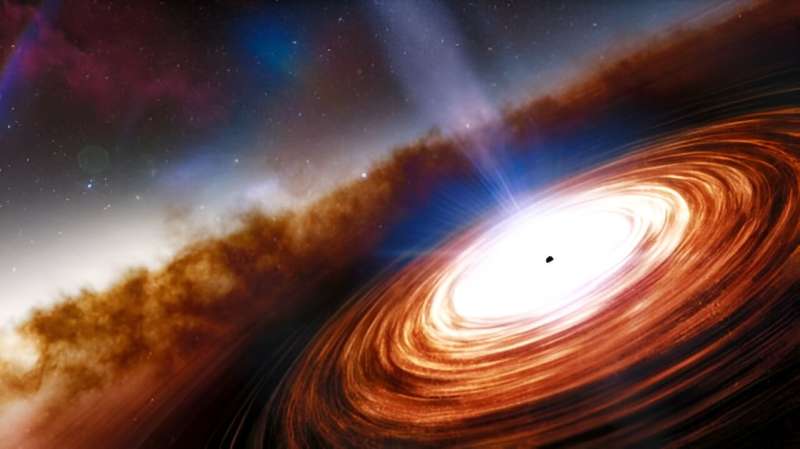Artist’s impression of an active supermassive black hole (SMBH) in the early universe. Pop III stars in the early universe were likely the precursors of supermassive black holes. Image source: NOIRLab/NSF/AURA/J.da silva
The earliest stars in the universe had an important mission. They are formed from primordial elements produced by the Big Bang and therefore contain no metals. They were responsible for synthesizing the first metals and spreading them into the nearby universe.
The James Webb Space Telescope has made some progress in finding the universe’s earliest galaxies. Could it have had the same success in the search for the first stars?
Finding the first galaxies in the universe is an extremely difficult task and one of the main motivations for building JWST. The light from these ancient objects is red-shifted into the infrared, and JWST is good at sensing infrared. Through deep-field observations in the infrared, space telescopes have located some of the earliest galaxies.
But the first stars were older than the first galaxies. The first stars formed about 500 million to 100 million years after the Big Bang, and their light ultimately ended the Dark Ages of the universe. Astrophysicists believe these stars are very large, with masses as high as 1,000 suns.
The new study is titled “Detection and Characterization of Highly Amplified Stars with JWST: Prospects in the Search for Population III Stars.”It will be published in Royal Astronomical Society monthly notices Currently available at arXiv Preprint server. The lead author is Erik Zackrisson of the Department of Physics and Astronomy at Uppsala University, Sweden.
“Due to the lack of efficient coolants and fragmentation in the chemically unrich gas during these early epochs, the resulting metal-free (aka Group III) stars are thought to be of extremely high mass (characteristic mass ~101,000 solar masses ),” the author wrote.
In order to see these early massive stars, JWST needs the help of gravitational lensing. The authors explain: “Gravitational lensing may allow single massive stars to be detected at cosmological distances, and several extremely magnified stars have been detected in recent years with redshifts reaching z ~ 6.” At z ~ 6, light takes more than 12.7 billion light-years to reach us.
Gravitational lensing takes advantage of a situation where a massive foreground object, such as a galaxy cluster, is located between us and the object we want to observe. When the target’s light rays pass through a foreground object called a gravitational lens, the light rays are magnified. This makes otherwise invisible objects visible.
The first stars had a redshift of about z=20, and if JWST could use gravitational lensing, it should be able to see this light. If they can, then powerful telescopes will start to provide us with observational evidence of a period in the early universe that so far we have mainly understood through theory: the era of reionization (EoR).
During the EoR, the universe is dominated by a dense, fuzzy haze of hydrogen gas. When the first stars formed, their ultraviolet light reionized the gas, allowing light to propagate. This is a crucial step in the life of the universe, so finding some of the ancient Pop III stars responsible is an important goal.
These first stars were remarkable in other ways, too, and they shaped our universe. They are massive, millions of times brighter than the Sun, and have short lifespans compared to stars like our Sun. They either explode into supernovae or collapse into black holes. Those that became black holes swallowed up gas and other stars and became the first quasars in the universe. Astrophysicists believe that these quasars grew into supermassive black holes through accretion and mergers, anchoring the centers of galaxies such as the Milky Way.
Those that explode as supernovae also play an important role. They forged elements heavier than hydrogen and helium, then scattered those metals back into space when they exploded. Stars that emerged later contained some of these metals, which also formed rocky bodies. Before Group III supernovae, there were no rocky planets and certainly no possibility of life. So these massive old stars, whether they ended up as supernovae or black holes, laid the foundation for the universe we see today.
If JWST succeeds, there won’t be any beautiful photos of these stellar ancestors. Instead, there will be data. Unraveling this data and determining whether there are Pop III stars in it is a complex task. The effort pushes the space telescope and the scientists who use it to their limits.
For one thing, it’s difficult to distinguish metal-rich stars from metal-poor Pop III stars spectroscopically. One reason is that most of these massive stars are likely binary pairs, which complicates the light signal. Another reason is that if the stars are still relatively young, they may be surrounded by nebular hydrogen, which also makes the light signal difficult to interpret.
If JWST can find some of these stars, the groundbreaking telescope’s already stunning success will be even more successful. It and the people who operate it are methodically checking off boxes on its list of scientific goals.
More information:
Erik Zackrisson et al., Detecting and Characterizing Highly Amplified Stars with JWST: Prospects in the Search for Population III Stars, arXiv (2023). DOI: 10.48550/arxiv.2312.09289
Provided by Universe Today
citation: Can Webb find the first star in the universe? (2023, December 20) Retrieved December 23, 2023, from https://phys.org/news/2023-12-webb-stars-universe.html
This document is protected by copyright. No part may be reproduced without written permission except in the interests of fair dealing for private study or research purposes. Content is for reference only.
#Webb #find #star #universe
Image Source : phys.org
